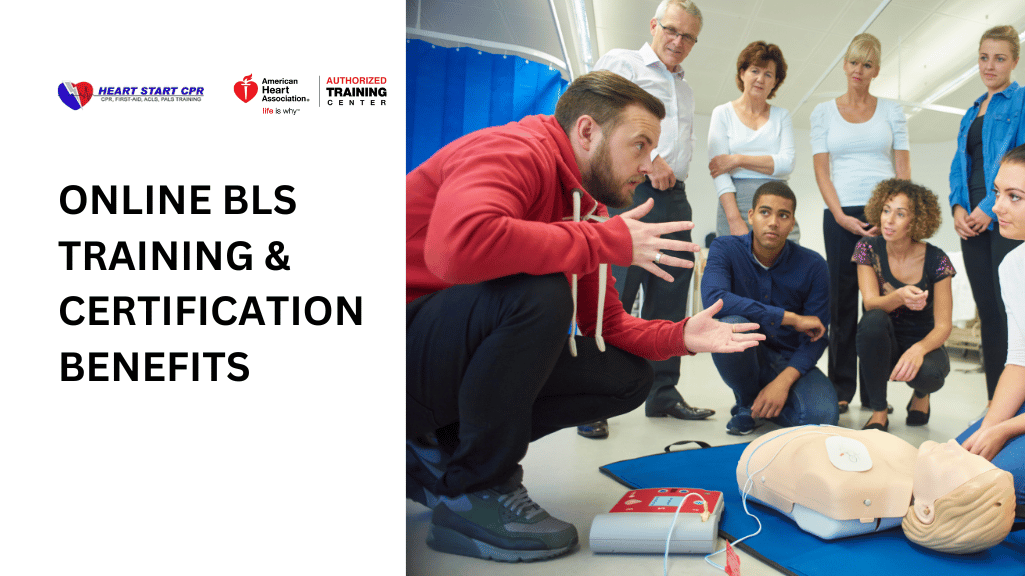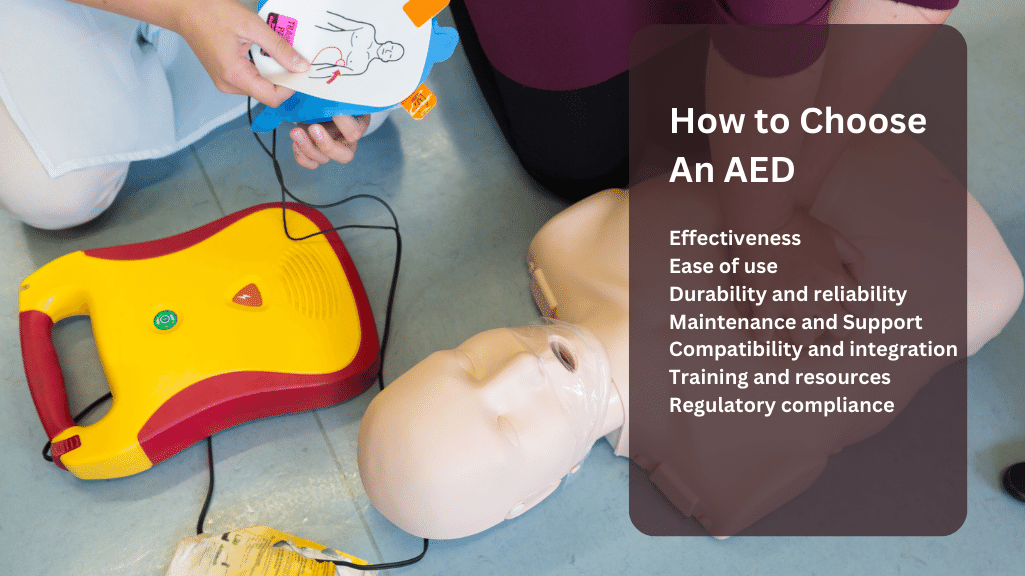
What Are The Types of Bleeding – Causes and First Aid
June 12, 2023
Benefits of Online BLS Training and Certification
July 4, 2023The Automated External Defibrillator (AED) is a portable medical device designed to deliver an electric shock to the heart during cardiac arrests. The AED Machines help to restore the normal rhythm of the heart. By providing immediate intervention in sudden cardiac arrest (SCA) cases, AEDs significantly increase the chances of survival.
In this article, we’ll cover the essentials of how to choose an AED. We’ll discuss how AEDs work and their importance in cardiac emergencies. You’ll learn about key features and specifications, regulations and certifications, evaluating manufacturers and brands, training and Support options, cost considerations, and legal aspects of AED deployment.
Factors to Consider to Choose the Right AED Device
When selecting an Automated External Defibrillator (AED), several key factors must be considered to ensure you make the right choice. Below is the breakdown of things that need to be considered before buying AED:
- Ease of use: Look for an AED designed to be user-friendly, particularly in high-stress situations. Opt for models with clear instructions, intuitive interfaces, and audio or visual cues guiding you through defibrillation.
- Portability: Consider the AED’s portability. The AEDs must be lightweight and easy to carry, allowing you to bring them to an emergency location quickly. Compact designs and taking cases enhance convenience and mobility.
- Durability and reliability: AEDs should be built to withstand various environments. Prioritize models that are durable, dust- and water-resistant, and renowned for their reliability. Features like maintenance reminders and self-checks can provide additional peace of mind.
- Pad placement and feedback: The AED should provide clear instructions on proper pad placement on the person’s chest. Visual guides or diagrams can be helpful in this regard. Some AEDs offer feedback on the quality of CPR being administered, such as indicating the need for compression depth or rate adjustments.
- Energy levels and escalating shocks: Look for AEDs that deliver escalating energy levels during defibrillation attempts. This means starting with a lower energy level and increasing as necessary. Such functionality helps minimize harm and enhances the chances of successful defibrillation.
- Training and Support: Check if the AED includes training resources like instructional videos or manuals. Some manufacturers may provide training programs or certifications. Additionally, consider the availability of customer support and technical assistance. Ensure that replacement parts and accessories are easily obtainable if needed.
- Cost: Remember that quality and reliability are essential when considering your budget. Investing in a dependable and user-friendly AED can significantly impact the chances of saving lives.
- Regulatory compliance: Ensure that the AED you select meets the regulations and certifications required in your region. Different countries may have specific standards for AEDs, so choosing one that complies with the relevant criteria is crucial.
How to Choose an AED Device? Assessing the Specific Needs and Environment

Before purchasing, you need to identify the requirements and conditions relevant to using an automated external defibrillator (AED). This assessment helps in determining the most suitable AED for particular surroundings. Here are the key steps in assessing the specific needs and environment:
Identifying the target setting for the AED device
- Home use: If the AED is intended for home use, it should be user-friendly and easy to operate. AEDs for home may be used by individuals without medical training. It should also be compact and portable for convenient storage and mobility within the home. Here is the guide to buying the best AED for a home from our experts.
- Office or workplace: A workplace AED should suit a professional environment. It should have clear instructions and intuitive operation to ensure employees can use it effectively during emergencies. Consideration should be given to the office space size and the number of employees when determining the number of AEDs required.
- Public places (schools, gyms, shopping malls, etc.): AEDs in public places should be prominent and easily accessible to the general public. They should be robust, capable of withstanding frequent use, and equipped with visual and auditory prompts to guide bystanders through resuscitation. The AEDs should also comply with any regulations or guidelines specific to the location.
Analyzing the potential risk factors
- Age groups and demographics: Assessing the age groups and demographics of the target surroundings is essential to determine the likelihood of cardiac events. Different age groups may have varying risk levels, and this information can help estimate the demand for the AED and the level of training required for potential users.
- Frequency of cardiac events: Understanding the frequency of cardiac events in the target surroundings can aid in determining the number of AEDs needed and their strategic placement. Gathering data from local healthcare providers, emergency services, or public health agencies can provide insights into the occurrence of cardiac emergencies in the area.
- Proximity to medical facilities: Evaluating the proximity of the target setting to medical facilities can influence the urgency of AED deployment. If the location is far from emergency medical services, having readily available AEDs becomes even more crucial. This factor may also impact the desired response time and the need for additional training or Support.
Considering environmental conditions
- Temperature and humidity requirements: Some AED models have specific temperature and humidity ranges in which they can operate effectively. It is essential to consider the environmental conditions of the target setting to ensure the AED functions optimally. Extreme temperatures or high humidity levels may affect the performance of the device.
- Durability and resistance to water or dust: The AED should be durable and resistant to water or dust in different environmental settings. For instance, AEDs may be exposed to conditions that could impact their functionality in public spaces or workplaces. Choosing AEDs with appropriate levels of durability and protection is vital to ensure their reliability over time.
Researching and Comparing AED Options
Online research
- Reliable sources for AED information: Reliable sources for AED information include reputable medical websites, manufacturers’ websites, and official guidelines from organizations such as the American Heart Association (AHA). These sources provide detailed information on AED features, usage guidelines, and regulatory standards.
- Reading customer reviews and testimonials: Customer reviews and testimonials can give valuable insights into different AED models’ real-world performance and user experiences. Reading reviews from individuals who have used the AEDs in various settings can help assess their reliability, ease of use, and overall satisfaction.
Consulting with medical professionals
- Seeking advice from doctors or cardiologists: Doctors or cardiologists can offer expert advice based on their knowledge and experience. They can provide recommendations on suitable AED models based on the needs and requirements of the environment the AED needs to be placed. They may also advise on AED implementation’s training and maintenance aspects.
- Reaching out to emergency medical services (EMS): EMS providers deal with cardiac emergencies regularly and can offer valuable insights into the AED models they use and recommend. Contacting local EMS organizations and discussing AED options with their personnel can help gain practical perspectives and align with existing emergency response protocols.
Comparison of different AED models
- Features and specifications: Compare the features and specifications of different AED models to ensure they meet the identified needs and requirements. Key considerations may include ease of use, visual and auditory prompts, electrode pad compatibility, battery life, and data retrieval and analysis connectivity options.
- Performance reviews and ratings: Look for performance reviews and ratings from reliable sources or independent testing organizations. These assessments can provide objective evaluations of AED models, including factors such as reliability, speed of analysis, and accuracy in detecting and treating cardiac rhythms.
Importance of choosing the right AED

Choosing the right Automated External Defibrillator (AED) saves lives during cardiac emergencies. Here are some key reasons why selecting the appropriate AED is crucial:
- Effectiveness: Advanced technology and accurate algorithms increase success rates. Look for AEDs with biphasic waveforms for higher efficacy.
- Ease of use: Choose AED with a User-friendly interface and clear visual and audio prompts. Minimal training is required for bystanders and first responders.
- Durability and reliability: Choose AEDs that can withstand different environments and conditions. Consider water resistance, shock resistance, and overall build quality.
- Compatibility and integration: Evaluate if the AED can integrate with other medical equipment or systems. Consider compatibility with patient monitoring systems or data integration.
- Training and resources: Availability of training resources, instructional videos, and user manuals. Some manufacturers offer comprehensive training programs.
- Regulatory compliance: Ensure the selected AED complies with relevant standards and certifications. Compliance ensures safety and quality standards are met.
Buy AED Devices from Heart Start CPR
Are you looking for a reliable and life-saving solution in case of cardiac emergencies? Look no further than Heart Start CPR! We offer a wide range of high-quality Automated External Defibrillator (AED) devices for the safety and well-being of the community.
Why choose Heart Start CPR for your AED needs? Here are just a few reasons:
- Exceptional Quality AED devices available
- Comprehensive Support on product selection and training.
- We offer Competitive Pricing.
Visit our website or call us at (877) 846-8277 to explore our range of AED devices and learn more about how we can support your cardiac emergency preparedness needs.






